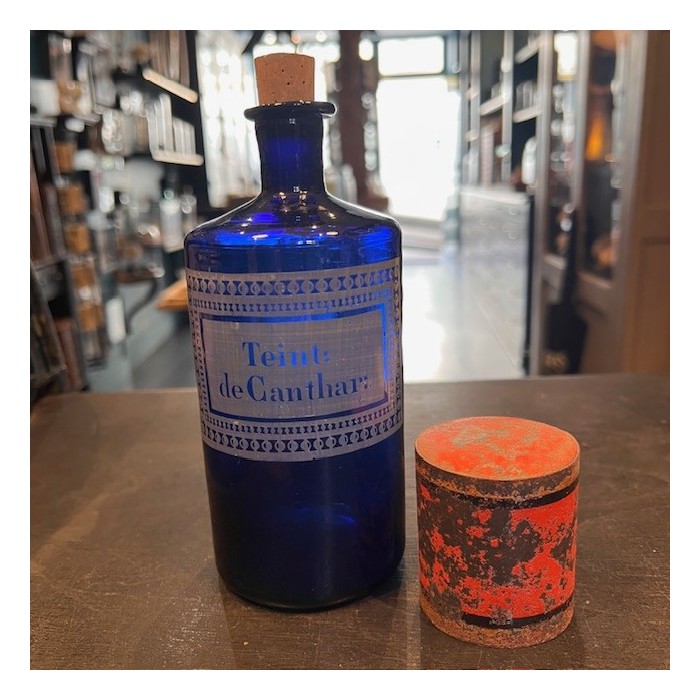- New










Teinture de Cantharides - POISON
Lytta vesicatoria - Spanish fly
Antique blue glass pharmacy bottle - Apothecary
Early 20th century - Blown glass.
Teinture de Cantharides - POISON
Lytta vesicatoria - Spanish fly
Antique blue glass pharmacy bottle - Apothecary
Early 20th century - Blown glass - Sheet metal cap
A manufacturing defect in the glass, a bubble: see photo
Blue glass was used for dangerous, toxic products and poisons. Pharmacists could identify them at a glance to avoid mistakes.
These insects have long been used as a remedy due to their irritant and vesicant properties.
But they were also used in the form of cantharides powder to be swallowed, which was a stimulant recommended for its supposed aphrodisiac properties, as a male sexual stimulant.
The active ingredient causes dilation of the blood vessels and irritation of the bladder and urethra. By irritating the penile urethra, cantharidin causes an erection in small doses but is fatal in high doses. This may be what happened to President Félix Faure, who died during sexual intercourse with his mistress at the Élysée Palace...
Spanish fly tincture was also recommended for external use, incorporated into small plasters to induce sweating and expel humors thanks to its vesicant properties.
But beware of the danger, as it causes painful blisters on the skin and, once ingested, this poison is considered as toxic as strychnine.
Spanish fly was listed in the 1884 French Codex, then appeared in the toxic table. It only disappeared from the Codex in the 1965 edition.
Height with cap: 20 cm Diameter: 7.5 cm
19th century pharmacy display blue jar
Blown glass
Sodium formate
Antique pharmacy bottle - Apothecary
There is still some product left inside
Antique surgical board
From Benjamin Bell's Complete Course in Surgery, published in 1796
Butterfly - Natural History color plate
Entomology
You buy 1 plate, not the whole set
Buckthorns syrup
Antique pharmacy bottle
Apothecary vial
Angelica Archangelica
Pharmacy jar - Herbalism - Apothecary bottle
Late 19th century, early 20th century
Antique surgical board
From Benjamin Bell's Complete Course in Surgery, published in 1796
Noirot Extract
Antique pharmacy bottle
Apothecary vial
Beautiful reflections in the glass
Central Pharmacy of the Civil Hospitals of Paris
Antique pharmacy bottle
Apothecary
Normaco - slime expelling
Antique tin medicine box
Empty
BYLA - Antique Pharmacy bottle in amber glass
Arséniate de Fer
Antique pharmacy bottle
Apothecary vial
Iodeol externe
Antique pharmacy bottle
Apothecary vial
EMPTY
Pocket microscope
Floroscope - Insectoscope in brass
1850's - 1930's
Antique metal bladder syringe of Dr Guyon
Beginning of XXth century
non-functional

Teinture de Cantharides - POISON
Lytta vesicatoria - Spanish fly
Antique blue glass pharmacy bottle - Apothecary
Early 20th century - Blown glass.








